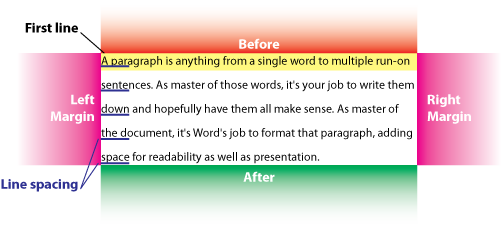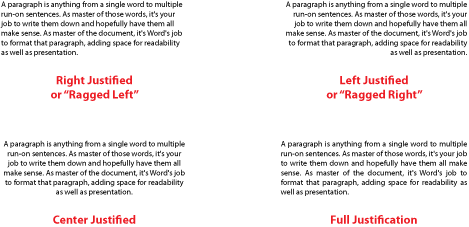A paragraph is anything from a single word to multiple run-on sentences. As master of those words, it’s your job to write them down and hopefully have them all make sense. As master of the document, it’s Word’s job to format that paragraph, adding space for readability as well as presentation.
While it seems like a simple thing to format a paragraph, in Word you’re not just dealing with a simple thing. A paragraph has multiple pieces and parts, each of which can be formatted or adjusted.
Figure 1 illustrates a typical paragraph in Word. I’ve called out the various formatting dojobbies associated with the paragraph.

Figure 1. Various things to format in and around a paragraph.
The first thing to notice about a paragraph is its justification. The four varieties are shown in Figure 2: Left, Right, Centered, and Full. These aren’t really the kind of paragraph formatting items that drive people nuts. Well — they can be: Using tabs in a paragraph that’s fully justified can look really funky, but that’s a topic for another blog post.

Figure 2. Paragraph justification examples.
From the typewriter days, line spacing is perhaps the most basic paragraph formatting option. As with a typewriter, you can space out lines of text within a paragraph at various intervals. The traditional single, double, and triple spacing commands are readily available. Being computer software, you can also direct Word to assign spacing in other intervals, either precisely or based on your whim. These commands are covered in my book, Word For Dummies.
The other spacing that drives people nuts is the Before and After spacing. This type of padding has nothing to do with the paragraph internally, which is the domain of the Line Spacing commands. The Before and After spacing is extra padding added either before or after the paragraph, as shown in Figure 1.
For the great body of text, Before and After spacing isn’t really used. I’ll add After spacing if I’m writing something where the text is single-spaced. That makes the paragraphs more readable. Otherwise, the Before and After spacing is used primarily with headings, figures, tablets, and other non-conforming paragraphs. The spacing helps separate those elements from the body of text, aiding readability.
A paragraph also has margins. These margins are different from the page margins, which can also be a source of confusion. Click here for an earlier blog post that describes the differences between a page’s margins and a paragraph’s margins.
Finally, the paragraph’s first line can be special. You can indent that line, keep it even with the left margin, or “out-dent” the first line in what’s called a hanging indent. Configuring these options is covered in my book as well, but generally speaking they do play a role with regards to paragraph spacing.
For example, if you’re going to indent the first line of each paragraph, you don’t have to add space between the paragraphs. That’s because the indented first line aids in readability. But if you don’t indent the first line, I recommend that you add space after each paragraph. Again, that aids readability.
If you’re interested in more specific design issues, I recommend picking up a copy of Looking Good in Print by Roger C. Parker. It’s an excellent, to-the-point tome on how to create readable text and well-formatted documents.


